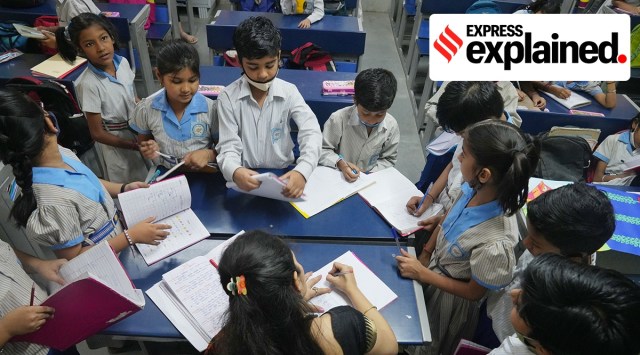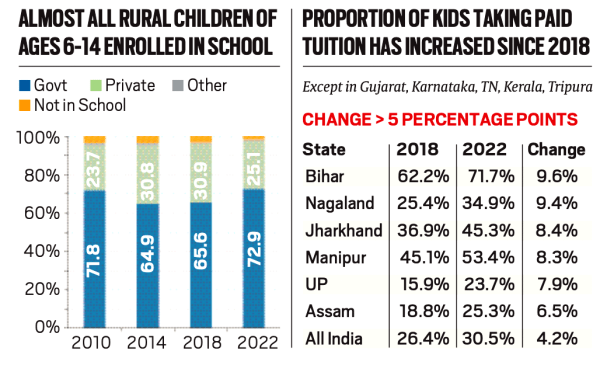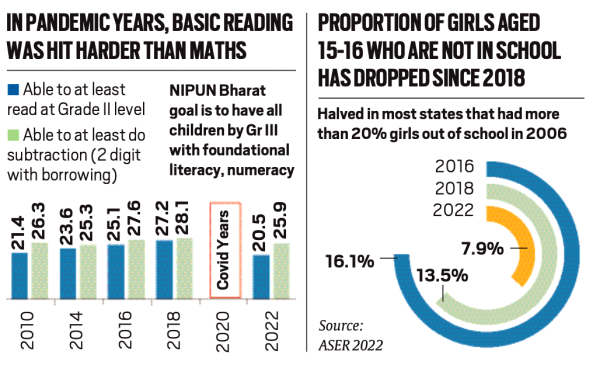An Expert Explains: Bright spots, areas of concern in the Annual Status of Education Report 2022
Enrollment has gone up even in a period when schools were shut, and we were already at very high levels before. It has risen further, including for older age groups, even though there was a fear that older girls, especially, may drop out.
 The Indian Express last year tracked the progress of students of Class 5 in a Delhi school. The report found mention in the ASER 2022. (Express photo by Abhinav Saha)
The Indian Express last year tracked the progress of students of Class 5 in a Delhi school. The report found mention in the ASER 2022. (Express photo by Abhinav Saha) Since 2005, ASERs survey children in the age group of 6 to 14 to record trends in school enrollment, attendance, and reading and arithmetic abilities. This year, nearly 7 lakh children across 616 districts were surveyed.
How has school enrollment been affected in the pandemic years?
Enrollment has gone up even in a period when schools were shut, and we were already at very high levels before. It has risen further, including for older age groups, even though there was a fear that older girls, especially, may drop out.
And then there is a big shift to government schools. I think we’ll need more analysis on what that means. Maybe it is temporary, but overwhelmingly, the voice of 7 lakh children and their families is that it is good to be back in school.
That carries with it both a kind of momentum and a responsibility. Now that the students are there, we have to make sure their attendance rises. Attendance patterns haven’t changed very much as schools have opened and there is a huge variation in attendance across the country. We need to break those patterns.
Have improvements in facilities like midday meals, toilets, etc. contributed to the increased enrollment?
Over time, there has been an improvement in infrastructure variables. I think systems do that as a matter of course. I feel that the issue of enrollments is coming potentially from the fact that during Covid, the rural private schools couldn’t do much because their own economy was very fragile. But being attached to the State, government schools distributed textbooks, they often distributed midday meals. The teachers were able to reach out in some form or fashion. So I think that there is a pull factor.
And from our usual experience, it is also the case that maybe family incomes have been hit, but everybody still believes that schooling must happen. I think that parental involvement and interest in education should be leveraged.
 Data on school enrollment of children in rural areas, those taking private tuitions.
Data on school enrollment of children in rural areas, those taking private tuitions.
 Data on the state of basic reading and maths among students and the proportion of girls (aged 15 to 16 years) who are not in schools.
Data on the state of basic reading and maths among students and the proportion of girls (aged 15 to 16 years) who are not in schools.
What could the corresponding increase in private tuition mean?
The reason private tuition went up is probably that it is more flexible. You could probably negotiate better with the provider, that this month I don’t have money, but next month I will. And so parents felt that schools are closed, we are not sure when they will open, but we need to get some extra help. In a way, I feel you can think about this as a local organising. Tuition can mean many things, but I’m saying it is also a function of parents wanting more for their children and going wherever possible to get it.
What is the trend on foundational skills, emphasised in the National Education Policy of 2020?
We go to various schools and ask questions about infrastructure. We asked whether, given schemes like National Initiative for Proficiency in Reading with Understanding and Numeracy (NIPUN) Bharat and Foundational Literacy and Numeracy (FLN) mission, have you received any guidelines and has any teacher been trained? Almost 80 per cent of the schools reported that we have received guidelines and teachers have been trained. This means that the seriousness with which governments are also sort of pushing on NIPUN Bharat is quite high. It makes the case for how to keep the momentum going.
There is a decline in learning levels since 2018, but again it varies across the country. And strangely — we have to understand from experts — why the drop in reading is more than in math. Is it because math, especially at such a basic level, is used by people much more? It’s hard to say, but we can see that recovery is possible.
The big point that I think would be useful to emphasise is that let us say NIPUN Bharat’s goals are that every child by Class three is at grade level, which means they can read or can do basic arithmetic. The number of such children before Covid was around 30 per cent, and now is somewhere for reading around 20 per cent and for math around 25-26 per cent.
What is the road ahead to improve these foundational skills?
In the past 10 years, we’ve seen improvement, but it has been in small bits. So it means that we really need to shake up things. Therefore, what we are going to do as a school system, as a family system, is to say that every year big jumps need to be taken. I think it is a critical thing for improving the productivity of the country. Business as usual is not going to work. Again, it’s not a new message, but it’s a message that needs to be reiterated. And perhaps because of the new education policy and the fact that after Covid, I think everybody’s mentality is slightly different, it is worth reinforcing.
I think an integration between the anganwadi system and the school system is urgently needed because the work starts there. There are anganwadis everywhere and their enrollment has gone up.
So how do we make sure that happens? The anganwadi system is generally less well-funded, at least for the education part. And what about the kids who are past Class 4, 5 now? They too have undergone learning losses. There’s a case for a big catch-up to be done there as well. In the next year’s plans, because most states will now go to their annual work plans for the next year, I’m hoping that these points can be considered.
Rukmini Banerji is the CEO of Pratham. She spoke to Rishika Singh
- 01
- 02
- 03
- 04
- 05






































